Service desk integration connects two or more service desk platforms to synchronize tickets, share data, and create unified support workflows across teams and organizations.
In some cases, an organization might have more than one service desk application, which means they need to find a way to integrate all of them.
That’s where service desk integration comes in. You need a system connecting multiple service desks to create a unified, coherent ecosystem for managing and monitoring all support services.
In this article, we covered:
- What service desk integration is and the difference between ITSM and service desks
- The main types of service desk integration organizations use
- Why organizations should integrate their service desks
- Common integration challenges and how to solve them
- Real-world use cases across platforms like Jira, Zendesk, ServiceNow, Freshdesk, and Freshservice
- How to implement service desk integration using Exalate
- Best practices for successful service desk integration.
What is Service Desk Integration?
Service desk integration is the process of unifying and consolidating data from two or more service desks in order to establish a seamless, coherent service ecosystem.

Here is a typical service desk integration scenario:
The support team uses Zendesk or Freshdesk to gather information about incidents or tickets reported by users, while the IT team uses Jira to resolve tickets that require the dev team’s attention.
In this scenario, the manager or admin has to integrate both Zendesk and Jira in order to streamline the efforts of both teams and ensure smooth collaboration.
What Are the Main Types of Service Desk Integration?
Service desk integration comes in multiple forms, each designed to solve specific business challenges. Similar to ITSM integration, service desk integration occurs in various forms:
- System Integration synchronizes service desk platforms to enable seamless workflows between internal teams or external partners. When your L1 support team in Zendesk escalates a ticket to your development team in Jira, system integration ensures the ticket, its complete history, comments, and attachments flow between both platforms in real-time.
- Data Integration helps customer success managers to pull ticket information from platforms like Zendesk, Freshdesk, and Jira Service Management into a unified dashboard.
- Point-to-Point Integration uses APIs or webhooks to establish a dedicated communication channel between exactly two tools.
- Hub-and-Spoke Integration uses a central integration hub that connects all service desks through a single intermediary platform, instead of creating individual connections between every system pair.
- Legacy System Integration connects modern service desks with older, on-premise ITSM platforms that may lack modern APIs or cloud connectivity.
- Middleware-Based Integration uses dedicated integration platforms (iPaaS solutions) that sit between service desks and handle all data transformation, routing, and orchestration logic.
- Self-Service Portal Integration connects knowledge bases and user portals with your service desk infrastructure to empower users to resolve common issues independently by accessing support articles, FAQs, and troubleshooting guides.
- Vendor Integration establishes connections between your organization’s service desk and external managed service providers, software vendors, or third-party support teams.
Hybrid Integration bridges cloud-based service desks with on-premise systems, a common scenario during cloud migration projects.
What’s the Difference Between ITSM and Service Desk?
A common misconception is that ITSM (IT service management) and service desk are interchangeable concepts. But the truth is that despite their similarities, some key factors differentiate both—I’ll show you how.
ITSM is a framework of practices and procedures governing the entire spectrum of IT services. It covers everything from detection to delivery, ensuring that the business requirements stay at the forefront.
So how does ITSM differ from the service desk?
Platforms like Zendesk, Freshdesk, Freshservice, ServiceDesk Plus, and even Jira Service Management can be used as service desks.
A service desk is only one aspect of ITSM, which focuses on handling technical issues for customers. It serves as a portal where users file service requests and get timely assistance.
That being said, the service desk has a smaller catchment area compared to the ITSM framework—a service desk is a sub-category of ITSM. While a service desk handles support services, ITSM focuses on managing the entire scope of service delivery.
| ASPECT | SERVICE DESK | ITSM |
| Scope | Single point of contact for IT support | Complete IT service lifecycle framework |
| Primary Focus | Incident resolution, service requests, customer support | Strategy, planning, delivery, and continuous improvement |
| Activities | Ticket management, L1/L2 support, issue escalation | Change management, asset management, problem management, SLA governance |
| Users | End users, employees, customers | IT teams, business stakeholders, executives |
| Tools | Zendesk, Freshdesk, ServiceNow Service Portal | ServiceNow ITSM Suite, BMC Remedy, Jira Service Management |
| Metrics | First response time, resolution time, CSAT scores | Business alignment, service availability, cost per service |
| Relationship | Component of ITSM | Framework containing service desks |
Why Should Organizations Integrate Service Desks?
There are many reasons why businesses choose to integrate their service desks. Here are just a few benefits:
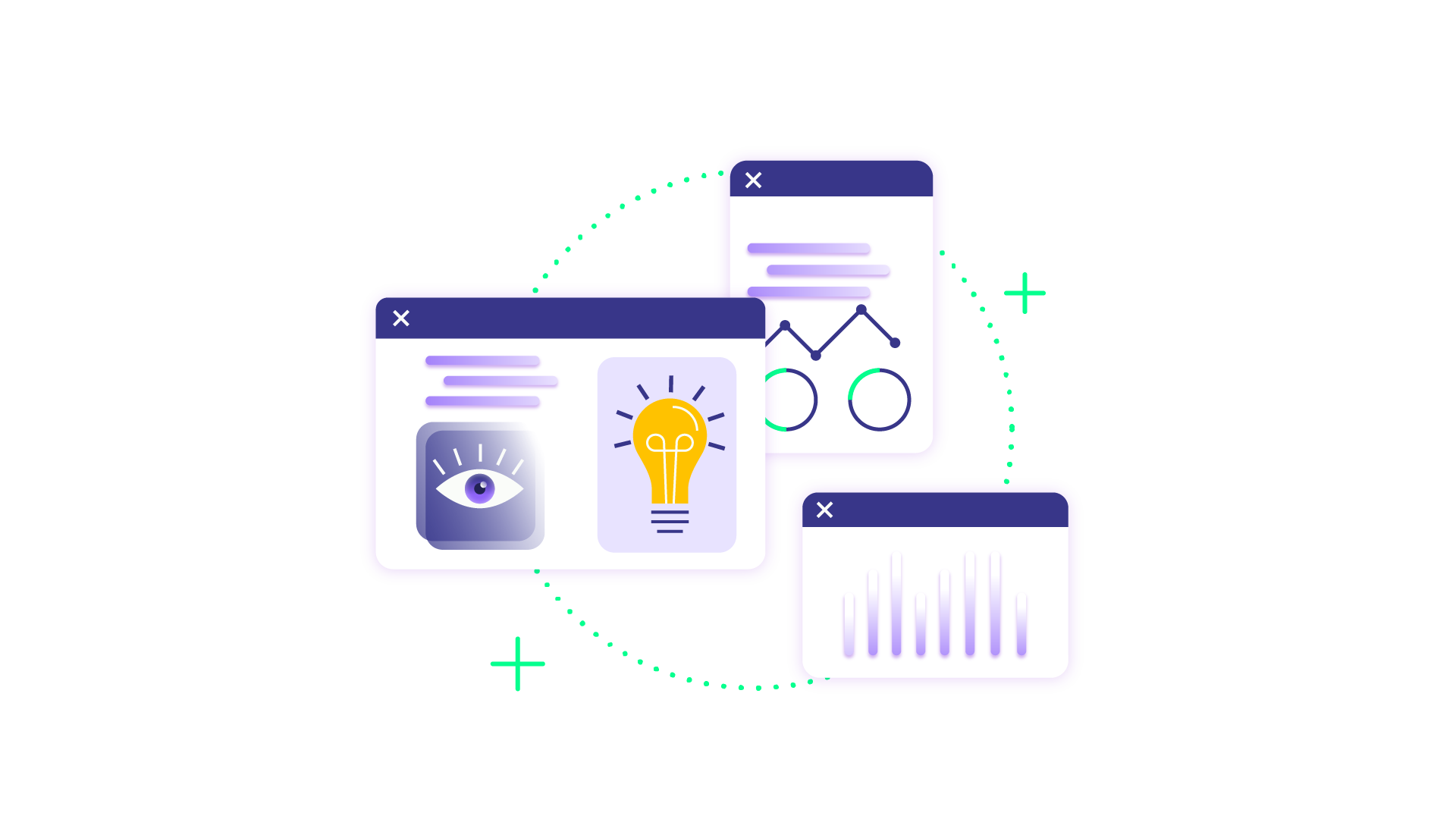
To Centralize Support Services
In companies where independent teams provide assistance to customers, integrating service desks will help centralize their efforts into a single hub in order to establish a central view.
This makes it easier for agents to stay on the same page when assisting customers and tracking incidents. Support managers no longer have to toggle between three different platforms to understand what’s happening across their teams.
This centralization means faster ticket location, consistent responses regardless of which system received the request, and executives who can finally see complete support metrics without manual data compilation.
To Improve Operational Efficiency
Service desk integration lets companies automate processes such as ticket prioritization and routing through a central platform. This decreases the time needed for sorting and responding to incidents, which also improves the average response time.
Automated ticket routing sends issues directly to the right team based on keywords, priority levels, or customer segments—eliminating the 30-45 minutes agents spend daily deciding where tickets belong.
When your Zendesk support team escalates to your development team on Jira, the ticket transfers instantly with full context instead of requiring someone to manually copy information between platforms.
To Foster Collaboration
As mentioned earlier, service desk integration gives agents and admins a central view. This makes collaboration easier since everybody has access to the same data sets and dashboards.
As a result, managers and support agents from different teams can share information seamlessly, fostering a collaborative work environment. Support agents in Freshdesk can see updates from developers working in Jira without sending status-check emails.
For organizations with external partners or MSPs, it enables vendors to see exactly what they need to resolve while your sensitive internal data stays protected within your system.
To Improve the User Experience
Integrating service desks provides a better user experience for customers (end users) and employees alike.
In the scenario mentioned earlier, employees will enjoy better access to real-time information, which will help them address incidents and change requests better. Similarly, the improved employee experience trickles down to the end users.
And how does this happen? When the agent has a better understanding of the incident as well as up-to-date information, they will be able to provide better, detailed assistance to the customer.
End users don’t care which service desk receives their request—they just want fast, accurate help.
To Improve Data-Oriented Services
When it comes to analysis and reporting, integrating multiple service desks is the best approach.
Centralizing your data makes it possible to unify everything into one portal, from which you can obtain updates, generate reports, and analyze performance. This will give you the insights needed to optimize operations in order to improve efficiency and customer satisfaction.
Service desk integration also eliminates duplicate tickets, inconsistent data entry, and reporting gaps. You can use it to analyze patterns across all your service desks, not five separate reports that you manually combine in spreadsheets.
To Reduce Operational Costs
Manual processes cost money. Every minute agents spend copying tickets between systems, searching for information across platforms, or waiting for updates from other teams adds to your support costs.
Integrating your service desks reduces the time spent on administrative tasks by 25-40%. It also reduces ticket volume by deflecting 30-50% of routine requests, letting your team focus on complex issues that truly need human expertise.
For MSPs, integration means one standardized process serves multiple clients instead of maintaining separate workflows for each customer.
To Enable Proactive Problem Management
Integrated service desks reveal patterns invisible in siloed systems. When three customers report similar issues across different platforms, integration connects these dots and flags the pattern for your problem management team.
You can identify root causes faster and implement permanent fixes instead of repeatedly addressing symptoms. Integrating monitoring tools also helps your team catch issues before users notice them.
To Support Scalability for Growing Organizations
As organizations grow, they acquire new tools, onboard new teams, and expand into new markets. Service desk integration provides the flexibility to add systems without rebuilding your entire support infrastructure.
When you acquire a company using a different service desk, integration lets both platforms coexist while sharing necessary information.
For organizations expanding internationally, integration connects regional service desks using local languages and currencies while maintaining centralized oversight.
Service Desk Integration Tools
When you want to integrate two or more service desks without compromising security and process efficiency, here are some tools to consider:
Zapier
Zapier is a workflow automation platform that allows users to connect multiple service desks, CRMs, ERPs, and applications in order to share data using Zaps.
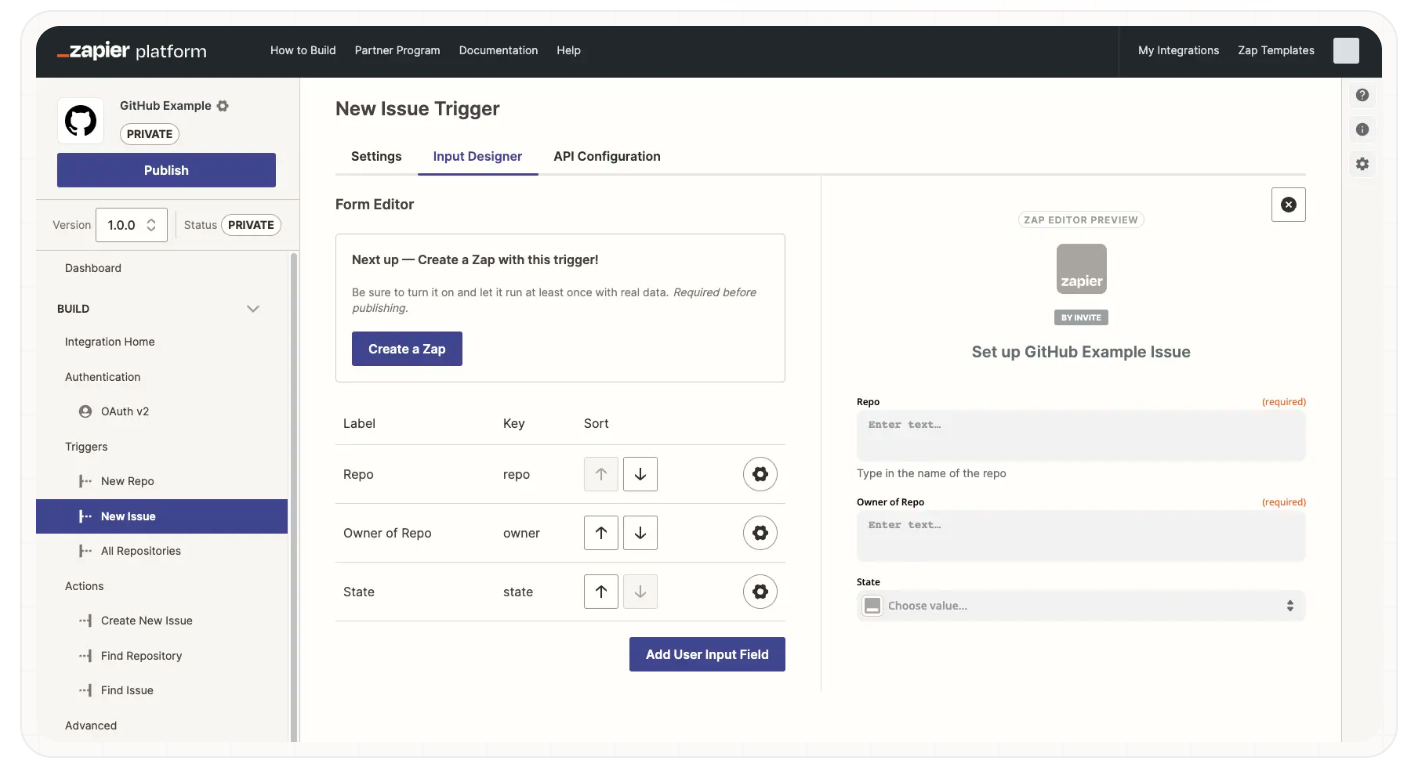
When you create Zaps between two service desks, you can configure triggers to control what gets sent and when it leaves.
Workato
Workato is an enterprise automation solution that allows users to connect enterprise applications. You can configure connections using Workato recipes—a set of instructions that controls the automation of complex workflows.
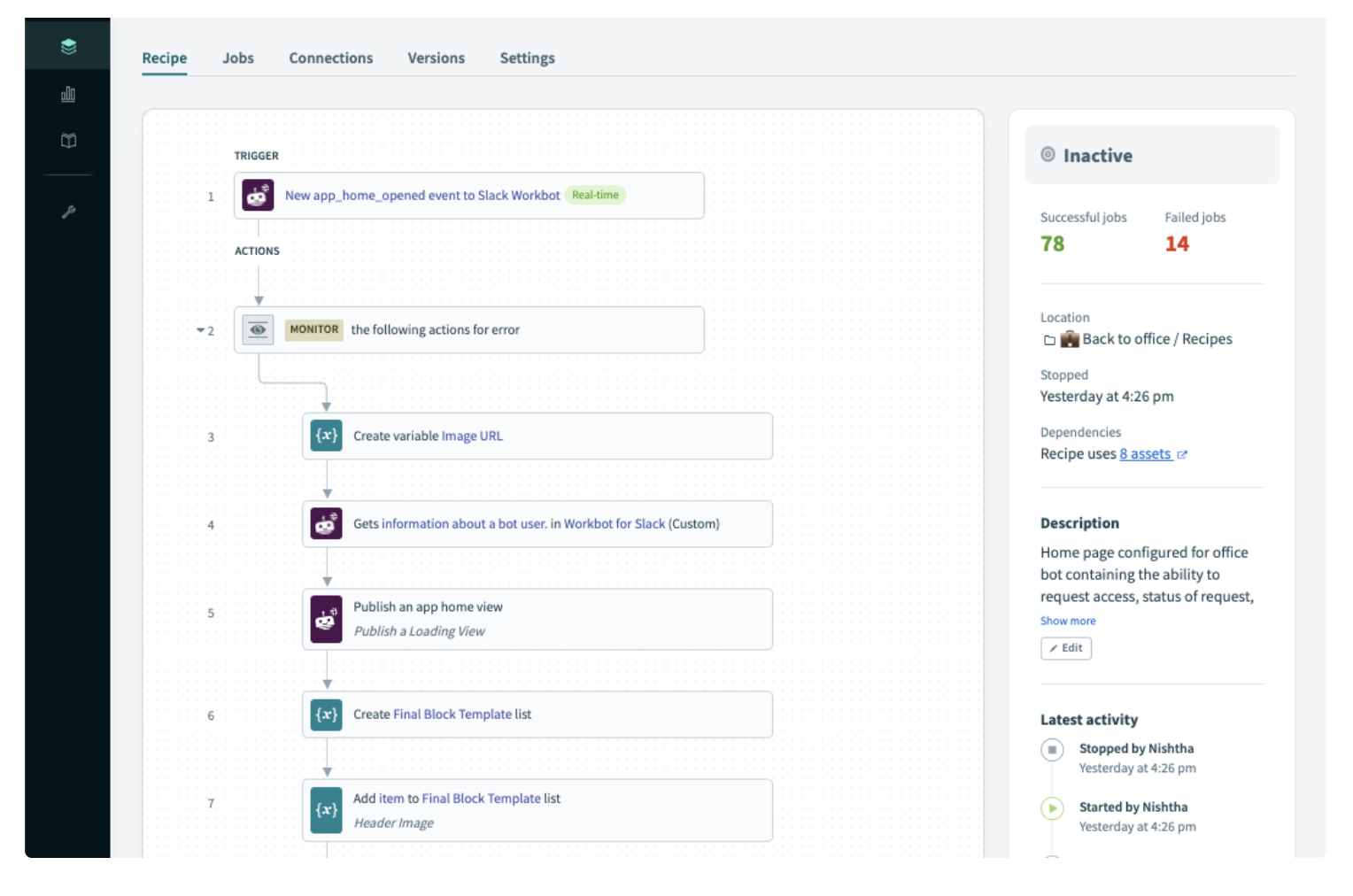
With Workato, users can integrate service desks in order to get access to both simple and complex features—from detecting the tone of the ticket to creating bots using AI and machine learning.
Exalate
Exalate is an iPaaS solution that is perfect for bi-directionally syncing two service desk platforms. Supported platforms include Jira (Service Management), Zendesk, Freshdesk, ServiceDesk Plus, and ServiceNow. Other supported services include Salesforce, Azure DevOps, GitHub, and more.
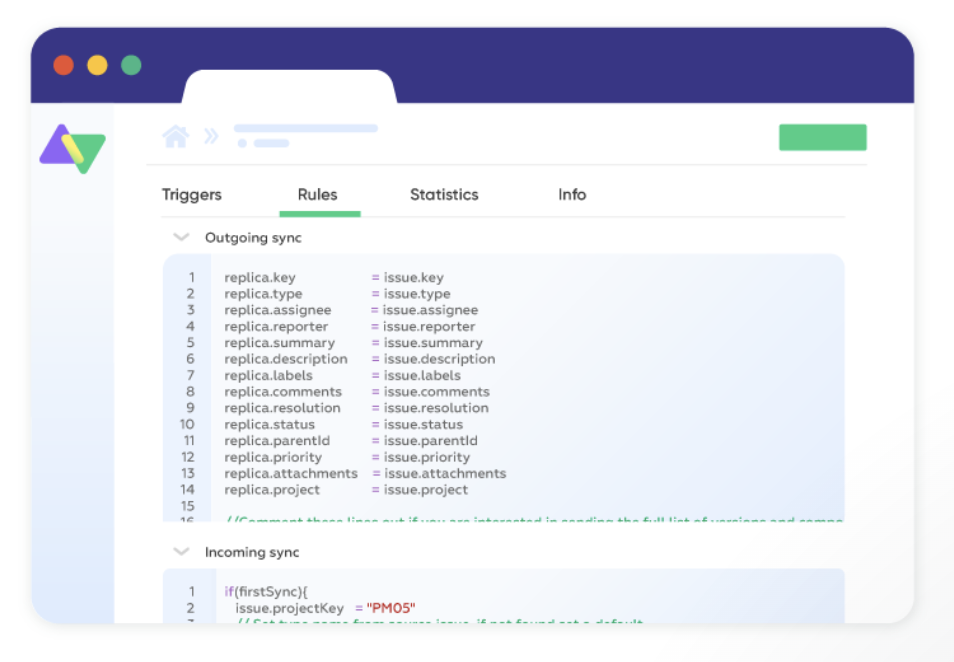
Exalate supports Basic and Script mode connections. The Basic mode supports simple configurations and field mappings.
The Script mode is a scripting interface that allows you to implement advanced service desk integrations by creating conditional logic or setting granular filters.
For instance, you can orchestrate end-to-end support workflows with Exalate.
And if scripting is not your thing, the Script mode comes with the AI Assist feature, which helps users generate custom scripts based on natural language prompts.
In terms of security, Exalate is a safe bet, thanks to its single-tenant architecture that gives every side of the integration independent control over their own instance. This means that only your admins can make changes to your side of the connection. You can access the trust center here.
Jitterbit
Jitterbit is an iPaaS solution that allows users to connect systems and build applications effortlessly. It works well for advanced IT teams looking to work with custom systems.
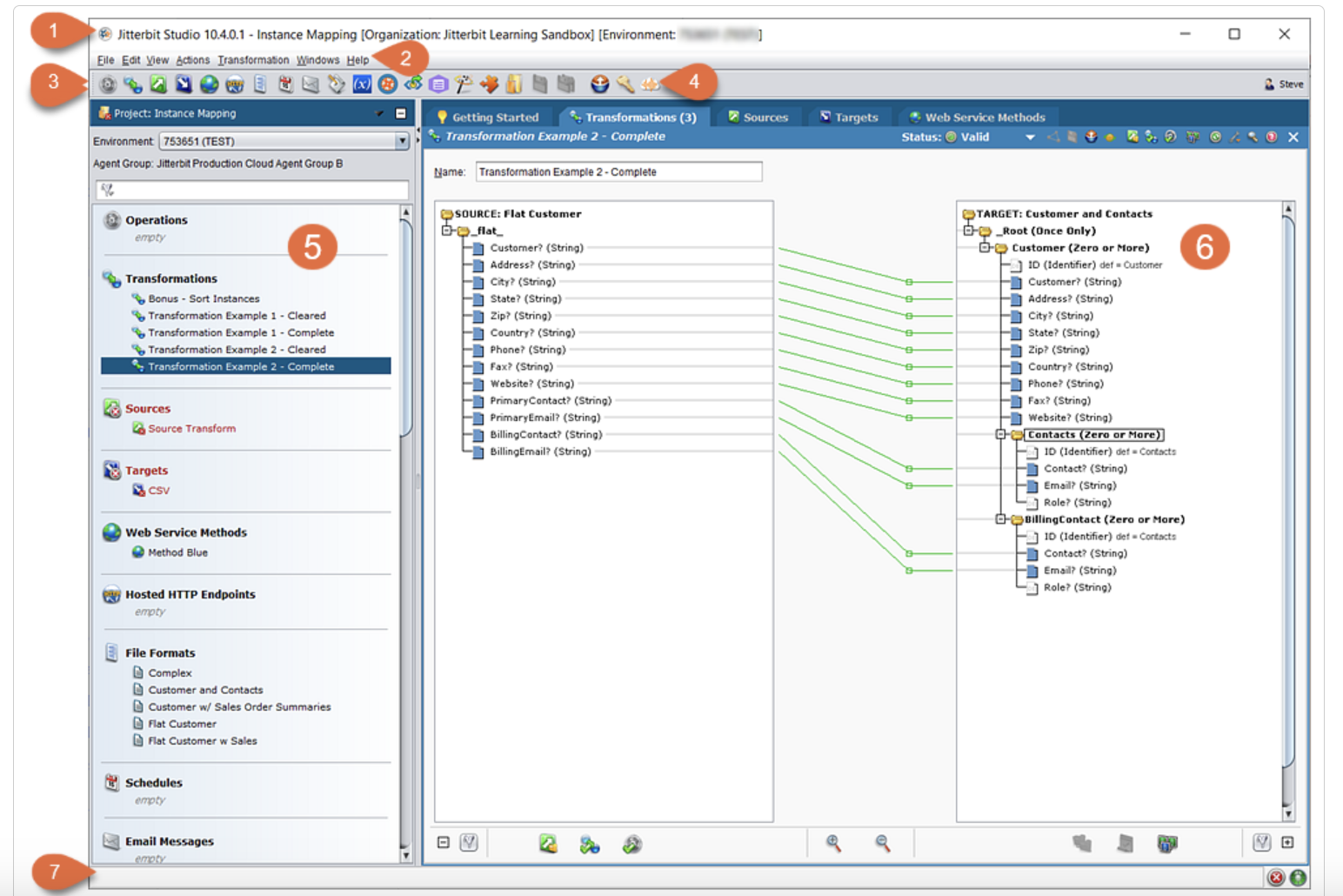
If you are looking for a low-code integration solution, Jitterbit Harmony is the answer. This platform allows you to automate workflows and streamline business processes across enterprise applications, legacy systems, and cloud services.
Microsoft Power Automate
Microsoft Power Automate is an integration solution that enables users to integrate service desks in order to share data and analyze incidents in real time. Thanks to its vast database of Actions and Flows, Power Automate allows users to automate workflows and improve service experience.

With Power Automate, you can access a vast library of pre-built connectors for connecting apps, service desks, CRM platforms, and ERPs. The AI Builder allows users to create intelligent automation and find insights using tailored AI models.
How to Implement Service Desk Integration Using Exalate
Implementing service desk integration with Exalate follows a structured approach that balances speed with customization. Here’s the step-by-step process for connecting your service desk platforms.
Step 1: Define Your Integration Requirements
Map out which service desks need to connect. For example, Zendesk for customer support and Freshdesk for internal IT.
Determine which data should sync between platforms: tickets, comments, attachments, status updates, priority levels, or custom fields. Then decide on sync direction—confirm if you need one-way data flow or bidirectional synchronization, where updates in either platform reflect in both systems.
Step 2: Install Exalate on Both Platforms
Install the Exalate app on each service desk platform you’re connecting. For cloud-based platforms like Zendesk or Jira Cloud, installation happens through the respective marketplace with just a few clicks.

For on-premise installations like Jira On-premise or ServiceNow, download the Exalate instance and follow the platform-specific installation guides.
For Freshdesk and ServiceDesk Plus installation, request a trial from our integrations page.
Step 3: Establish the Connection
Exalate offers two integration approaches depending on your technical requirements. Basic Mode provides a visual interface where you map fields between platforms. This works well for straightforward integrations where standard field mappings meet your needs.
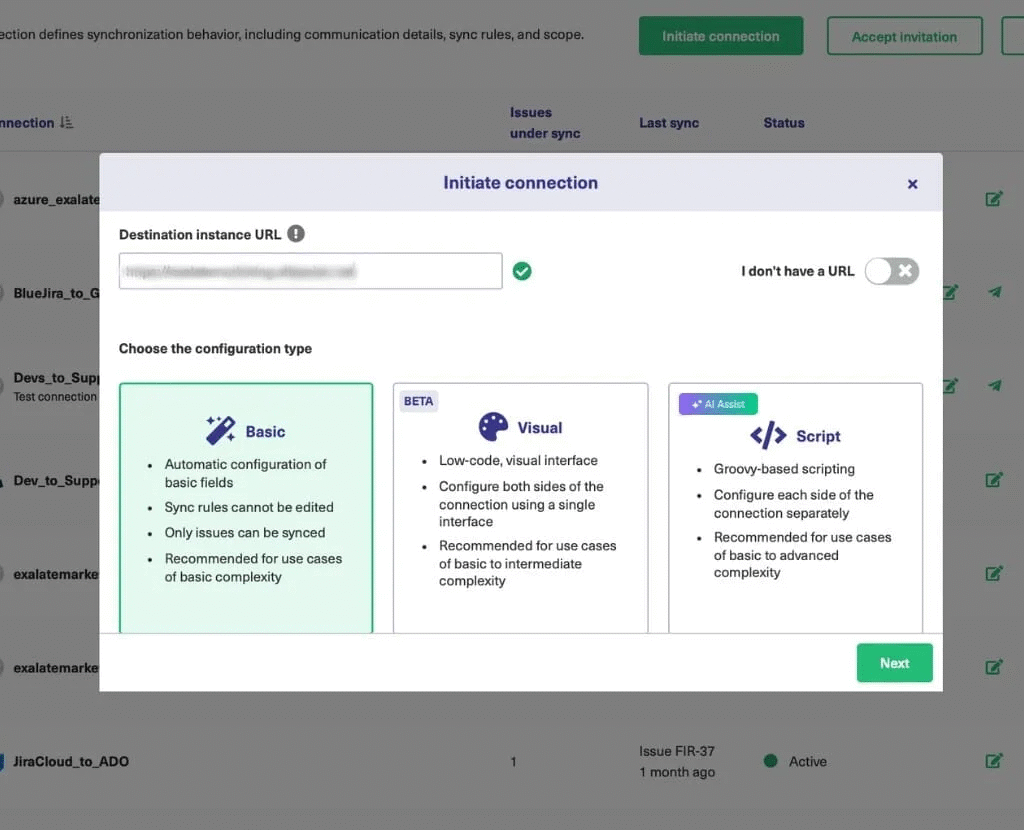
Script Mode uses Groovy scripting to build custom integration logic, enabling complex workflows like conditional field mapping, data transformation, or multi-step automation.
Navigate to Exalate’s connection settings and generate an invitation link from one platform. For Script Mode connections, copy the invitation code to the second platform to establish the secure connection.
Step 4: Use AI to Configure Field Mappings and Sync Rules
To define which information syncs between your service desks, you have to map standard fields like summary, description, status, priority, and assignee between platforms.
You can also configure custom field mappings for organization-specific data—customer IDs, SLA tiers, product categories, or internal reference numbers.
If you need advanced integration logic but don’t want to write Groovy scripts manually, use Exalate’s AI-powered integration assistant.
It allows you to describe your requirements in plain language. For example, “Map statuses between both systems so that ‘new’ is ‘open’ and ‘solved’ is ‘done’.”

The AI assistant generates the corresponding Groovy script, which you can review and adjust before implementing. This bridges the gap between Basic Mode’s simplicity and Script Mode’s power, making complex integrations accessible without deep scripting knowledge.
Step 5: Test Your Integration
Before going live, test your integration thoroughly with sample data. Create test tickets in one platform and verify they appear correctly in the other platform with all expected fields populated.
Update test tickets and confirm that changes sync bidirectionally if that’s your configuration. Test edge cases like tickets with special characters, large attachments, or unusual field values.
You should also verify that your sync triggers work as expected—tickets meeting your criteria sync while others remain isolated. Check that security rules function properly, ensuring sensitive data stays protected according to your configuration.
Step 6: Monitor and Optimize Performance
After deployment, monitor your integration’s performance using Exalate’s dashboard. Track sync success rates, identify any failed synchronizations, and review error logs to troubleshoot issues.

Once your initial integration runs smoothly, expand to additional service desks or teams. Add connections for new departments, regional offices, or external partners as needed.
For MSPs managing multiple clients, Exalate’s single-tenant model means you can replicate proven integration templates across customer accounts while maintaining complete data isolation between clients.
Common Service Desk Integration Challenges (and How to Solve Them)
Here are the most common challenges and practical solutions to overcome them.
Data Mapping Inconsistencies
Different service desk platforms use different field names, data types, and values for the same information. Zendesk uses priority values like “Urgent, High, Normal, Low” while Jira uses “Highest, High, Medium, Low, Lowest.” Custom fields create even more complexity; a specific field in ServiceNow might not exist in Freshdesk at all.
The Solution: Create a data mapping document that defines how fields translate between platforms before starting integration. Use integration tools with transformation capabilities to convert values automatically—mapping Zendesk’s “Urgent” to Jira’s “Highest” without manual intervention.
For fields that don’t have direct equivalents, decide whether to create custom fields in the target platform, store the data in description/comment fields, or exclude it from synchronization. Tools like Exalate let you write transformation logic that handles these mappings automatically.
Security and Data Privacy Concerns
Integrating service desks means data flows between systems, potentially crossing organizational boundaries when working with MSPs or vendors.
Organizations worry about exposing sensitive customer information, violating compliance requirements like GDPR or HIPAA, or giving external partners access to internal data they shouldn’t see.
The Solution: Implement integration platforms with granular filtering and single-tenant architecture. Configure field-level permissions that sync only necessary information. External vendors might see ticket summaries and status updates, but not customer email addresses or payment information.
Use data masking for sensitive fields like phone numbers or account IDs when syncing to external systems.
Most importantly, choose integration solutions that maintain data sovereignty, where each organization controls what leaves their environment rather than pooling data in shared middleware.
Mismatched Workflows and Business Processes
Each service desk platform reflects the unique workflows of the teams using it. Your support team’s five-stage ticket lifecycle in Zendesk doesn’t match your development team’s eight-stage process in Jira.
When tickets sync between systems with mismatched workflows, status updates become confusing and automation breaks down.
The Solution: Map workflows between platforms by identifying equivalent stages and status updates—Zendesk’s “Open” might correspond to Jira’s “To Do” while “Pending” maps to “In Progress.”
Use status translation rules in your integration to convert values automatically. For workflows that truly don’t align, consider creating intermediate statuses or using a common subset of stages that both platforms share.
Performance and Sync Latency Issues
Large organizations process thousands of tickets daily. When integration performance lags, tickets take minutes or hours to appear in the target system, creating confusion when agents don’t see recent updates. Sync failures accumulate, creating backlogs that require manual intervention to resolve.
The Solution: Choose integration platforms designed for high-volume scenarios with asynchronous processing and queue management. Implement selective syncing that transfers only tickets meeting specific criteria rather than syncing everything—you might sync only high-priority tickets or those tagged for specific teams.
Use webhook-based integrations for real-time updates instead of polling-based approaches that check for changes on fixed schedules. Monitor integration performance regularly and scale infrastructure as ticket volumes grow.
For extremely high-volume scenarios, consider scheduled batch syncing for lower-priority tickets while maintaining real-time sync for urgent issues.
Lack of Technical Resources and Expertise
Many organizations lack in-house integration expertise. Building and maintaining custom API integrations requires developers who understand both platforms, authentication methods, error handling, and ongoing maintenance. Small IT teams can’t dedicate resources to writing and troubleshooting integration code.
The Solution: Use low-code or no-code integration platforms that provide visual interfaces instead of requiring custom development.
Platforms like Exalate offer Basic Mode with dropdown field mapping that non-developers can configure. For more complex requirements, leverage AI-powered tools like Exalate’s AI Assist that generate integration scripts from natural language descriptions.
Start with pre-built integration templates provided by iPaaS vendors rather than building from scratch. And ultimately, invest in training programs for existing IT staff on integration platforms to build internal capabilities over time.
Legacy System Compatibility
Older on-premise service desks lack modern REST APIs. These legacy systems use outdated protocols, require direct database access, or have limited customization options that prevent standard integration approaches.
The Solution: Use enterprise integration platforms with legacy connectors specifically designed for older ITSM systems. Consider middleware that can translate between modern APIs and legacy protocols like SOAP or direct database connections.
For systems without any API access, evaluate screen-scraping tools or robotic process automation (RPA) as a temporary bridge. Plan a phased migration strategy that uses integration to transition from legacy systems to modern platforms gradually.
Integration Maintenance Over Time
Service desk platforms release updates that change APIs, deprecate features, or modify data structures. An integration working perfectly today breaks after a vendor updates their platform. Organizations discover integration failures weeks later when accumulated sync errors create visible problems.
The Solution: Choose integration platforms that handle vendor API changes automatically rather than requiring manual updates to custom code. Set up monitoring and alerting that immediately notifies administrators when sync failures occur.
Test integrations in sandbox environments after major platform updates before they affect production. Build error handling into your integration logic that logs failures and retries automatically rather than silently dropping data.
Cost Justification and ROI Concerns
Integration projects require upfront investment in software licenses, implementation time, and ongoing maintenance. Executives question whether integration costs justify the benefits, especially when teams have managed with manual processes for years.
The Solution: Calculate current costs of manual ticket handling—hours spent copying information between systems, delays caused by handoff friction, and duplicate work across teams.
Document time savings from automation, showing that eliminating 30 minutes of manual work per agent daily translates to substantial annual cost savings. Track metrics before and after integration, like average resolution time, first-response time, and customer satisfaction scores, to demonstrate tangible improvements.
Service Desk Integration Use Cases
Here are proven use cases showing how organizations connect platforms like Jira, Zendesk, Freshdesk, Jira Service Management, ServiceNow, Freshservice, and ServiceDesk Plus using Exalate.
Connecting Customer Support with Development Teams
Support teams typically use platforms like Zendesk, Freshdesk, or Freshservice to manage customer inquiries, while development teams work in Jira Software or Jira Service Management to track bugs and feature requests.
With Exalate, organizations can sync tickets bidirectionally between these platforms. When a Zendesk ticket requires development attention, Exalate automatically creates a Jira task with all relevant context—ticket summary, description, customer priority, and affected product version.
As developers update the Jira issue with progress notes or resolution details, those updates flow back to Zendesk so support agents can keep customers informed without switching platforms.
A SaaS company using this integration pattern syncs specific Zendesk fields, including ticket subject (mapped to Jira summary), description (with rich-text formatting preserved), priority levels, custom fields, attachments, and all public comments while filtering out internal notes.
MSP Multi-Client Service Desk Management
Managed Service Providers face unique challenges managing support operations across dozens or hundreds of client organizations.
Some clients use ServiceNow, while others prefer Freshservice or ServiceDesk Plus, while the MSP maintains its internal operations in Jira Service Management.
Exalate solves this problem by creating separate integrations for each client while maintaining complete data isolation. The MSP’s Jira Service Management instance connects to each client’s service desk through individual Exalate connections.
When a client reports an issue in their ServiceNow instance, Exalate creates a corresponding ticket in the MSP’s Jira Service Management with appropriate context about which client it belongs to, the service level agreement terms, and escalation requirements.
An MSP managing IT services for enterprise clients implemented this pattern to standardize operations. They sync essential fields including ticket ID, summary and description, status updates, priority and urgency levels, SLA timers and deadlines, and resolution notes.
The MSP reports a 40% reduction in time spent on administrative ticket management and improved SLA compliance rates.
Internal IT Service Management Across Departments
Large enterprises often run multiple service desk instances across different departments. The IT department might use Jira Service Management for infrastructure requests, HR uses Freshservice for employee onboarding, and facilities management operates ServiceDesk Plus for building maintenance.
When issues require cross-departmental coordination—like onboarding a new employee, which involves IT equipment, HR paperwork, and office space—information needs to flow between these isolated systems.
As each department completes their portion of the onboarding process, status updates sync across all platforms so coordinators see the complete picture.
A financial services firm with thousands of employees implemented this integration pattern across departmental service desks. They sync employee information, including full name, employee ID, department, location, start date, and manager details.
The company reduced the average onboarding time from 14 days to 8 days by eliminating communication delays between departments.
Multi-Region Service Desk Consolidation
Global organizations often operate regional service desks in different markets, each using platforms suited to local requirements.
European operations might use ServiceNow for GDPR compliance features, Asian operations prefer Freshservice for regional language support, and North American teams work in Jira Service Management.
Executive leadership needs consolidated visibility across all regions while allowing each to operate with appropriate local tools.
Connecting service desks creates a unified view, which allows each regional service desk to continue operating independently while syncing aggregated data to a central reporting instance.
Regional teams maintain autonomy over their workflows, data models, and user interfaces, but standardized information flows to headquarters for enterprise-wide analytics and resource allocation decisions.
A logistics company with operations in multiple countries implemented this pattern. Each region maintains its preferred service desk platform. They also sync standardized fields, including incident category taxonomy, severity levels, affected business units, and customer satisfaction scores.
The result is that the company gained better global visibility into support operations, identifying that certain incident types concentrated in specific regions required targeted training investments.
Change Management and Incident Coordination
When planned changes cause incidents, or when recurring incidents reveal the need for infrastructure changes, information must flow between change records in ServiceNow or Jira Service Management and incident tickets in various service desk platforms.
Your integration can automatically link related incidents and changes across platforms. So when a scheduled maintenance window in ServiceNow connects to a system deployment tracked in Jira, Exalate links any incidents reported during that window back to the originating change.
This provides change managers with immediate feedback about change impacts and helps incident responders understand that a spike in database connection errors correlates with a database version upgrade, which helps teams troubleshoot faster.
A cybersecurity MSSP implemented integration between Jira (for development changes) and ServiceNow (for incident management). They sync change implementation timestamps, affected system components, related incident ticket IDs, and post-implementation review notes.
The integration includes custom logic that automatically creates problem records in ServiceNow when three or more incidents link to the same change within 24 hours, triggering deeper investigation. The company improved change success rates from 87% to 96% by identifying problematic patterns earlier.
What are the Best Practices for Service Desk Integration?
For any service desk integration effort to succeed, there are some best practices you need to follow. Here are some tips to consider when integrating service desks internally or externally.
Always Work With a Plan
Before implementing service desk integration, the first port of call is to establish a strategy that aligns with your needs and prospects. You need a clear understanding of what you want to achieve with the integration and how it ties into your organizational requirements.
In addition, your integration plan must account for timelines, deliverables, milestones, responsibilities, and expectations. You also have to factor in the tools needed for gathering data and sharing updates.
Don’t Shy Away From Automation
Dread it, run from it, but automation is here to stay. You just have to embrace it as part of the service desk integration reality.
Consider using automated integration solutions to reduce the bottlenecks in manual integrations. By thoroughly assessing your existing service desk processes, tools, and data, you can spot potential areas for improvement and project-relevant automation, such as chatbots and virtual assistants. You should also look for tools with AI-powered assistants and chatbots.
One potential implementation of automation in the service desk integration landscape is in Exalate’s AI Assist. This feature relies on human prompts and AI-generated output to synchronize tickets and foster real-time interaction between the two independent systems. We will learn more about Exalate in a while.
Track Progress and Key Metrics
After integrating data from different service desks, you need to monitor key metrics to know when to make changes. This will determine whether the integration solution is the perfect fit for you.
Imagine integrating Zendesk or Freshdesk with Jira Service Management using a third-party integration solution like Exalate or Zapier.
You can use accurate reporting tools to monitor the progress and quality of the responses to incident requests. This will help boost the customer satisfaction (CSAT) score, reduce the resolution time, and clear your backlogs.
Document Integration Configuration Thoroughly
Integration configurations become complex quickly, especially when using script-based tools or implementing custom transformation logic. So, maintain comprehensive documentation that explains your field mappings, sync triggers, conditional logic, and transformation rules.
Document not just what the integration does but why—explain the business reasoning behind decisions like “we sync only public comments to external systems because internal notes contain strategic information.”
Document procedures for scenarios like “what to do when tickets stop syncing,” “how to manually trigger sync for stuck tickets,” or “process for adding new custom fields to existing integrations.”
This documentation will come in handy when the person who configured the integration leaves the organization or when you need to diagnose problems under pressure during an outage.
Invest in User Training and Change Management
Conduct hands-on training sessions that show agents exactly how to escalate tickets, where to find updates from other teams, and what they need to do differently now that systems are connected.
Create quick reference guides with screenshots showing integrated workflows—”How to escalate a Zendesk ticket to Jira development”.
Take the time to designate integration champions within each team who receive advanced training and can answer colleagues’ questions. These champions serve as the first line of support for integration questions.
Gather feedback continuously from users about friction points, missing data, or workflow improvements—the best integration optimizations come from people using the system daily.
Use Secure Integration Tools
I’ve already hinted at using integration tools to automate processes and improve reporting. But you should always prioritize security when choosing a service desk integration solution.
Why? Well, because you want to keep your customer data safe from unauthorized access. Besides, when integrating data with that of another company, you have to ensure that the tool you’re using grants you complete control from your end. This is possible when the service desk integration platform supports single tenancy.
With Power Automate, you can access a vast library of pre-built connectors for connecting apps, service desks, CRM platforms, and ERPs. The AI Builder allows users to create intelligent automation and find insights using tailored AI models.
Key Takeaways
- Service desk integration connects multiple service desk platforms to create a unified support ecosystem for better ticket management and team collaboration.
- Service desks handle day-to-day support tickets, while ITSM is the broader framework governing all IT service delivery.
- Organizations use different integration types, including point-to-point, hub-and-spoke, legacy, middleware, vendor, cloud-to-cloud, and hybrid integrations.
- Organizations face data mapping inconsistencies, security concerns, workflow mismatches, performance issues, technical resource gaps, duplicate tickets, user adoption resistance, and legacy system compatibility.
- Integration centralizes support operations, improves efficiency by 25-40%, enhances team collaboration, boosts customer satisfaction by 20-30%, enables better reporting, reduces costs, supports proactive problem management, and provides scalability.
- Real-world applications include connecting support with development teams, MSP multi-client management, cross-departmental workflows, vendor collaboration, L1-to-L2 escalation, and asset management enrichment.
- Successful implementation requires defining requirements, installing on both platforms, establishing connections, choosing integration mode (Basic or Script), configuring field mappings, optionally using AI Assist, thorough testing, monitoring performance, and scaling to additional platforms.
- Start with clear goals, choose the right architecture, implement gradual rollouts, design bidirectional sync carefully, establish security policies, automate intelligently, monitor continuously, document thoroughly, invest in training, plan for data migration, build flexibility, and measure ROI.
If you’re considering service desk integration and have any questions or concerns, book a session to discuss them with an integration engineer.
FAQs
What is service desk integration?
Service desk integration is the process of connecting two or more service desk platforms to synchronize tickets, share data, and create unified support workflows across teams and organizations. Exalate enables bidirectional integration between platforms like Jira, Zendesk, ServiceNow, Freshdesk, Freshservice, and ServiceDesk Plus, giving each side complete control over their data.
What’s the difference between ITSM and a service desk?
A service desk is a single component within ITSM (IT Service Management). ITSM is the complete framework for managing all IT services across an organization, covering strategy, planning, delivery, and continuous improvement. The service desk specifically handles incident resolution, service requests, and user support. Exalate integrates service desk platforms within your broader ITSM ecosystem to enable seamless workflows.
How does Exalate differ from other integration tools?
Exalate uses a single-tenant architecture where each organization maintains its own Exalate instance with complete control over its data. This makes Exalate ideal for MSPs, regulated industries, and external vendor collaboration.
What fields and data can Exalate sync between service desks?
Exalate syncs standard fields like ticket summary, description, status, priority, assignee, reporter, comments, attachments, labels, due dates, and SLA timers. It also handles custom fields specific to your organization—customer tier, product version, escalation codes, internal reference numbers, or any custom data structures. Using Script Mode, you can apply conditional logic, data transformations, and filtering rules to control exactly what syncs and how it’s formatted in each platform.
Can Exalate integrate with legacy service desk systems?
Yes, Exalate supports both cloud and on-premise service desk platforms. It integrates with legacy systems like Jira On-Premise/Data Center, ServiceNow on-premise instances, and ServiceDesk Plus on-premise deployments.
Exalate’s flexible architecture handles REST APIs, SOAP protocols, and various authentication methods, enabling organizations to modernize gradually without immediately retiring legacy platforms.
How much does Exalate cost for service desk integration?
Exalate pricing varies based on the platforms being connected, the number of connections, and the support level needed. Visit the detailed pricing and licensing page to find out more information.
What security measures does Exalate provide?
Exalate’s single-tenant architecture means each organization runs its own isolated instance—your data never passes through shared infrastructure. You control what data leaves your system through field-level filtering, data masking, and Groovy script logic. Exalate supports encrypted connections, role-based access controls, comprehensive audit logging, and meets compliance requirements for GDPR, HIPAA, and SOC 2. Find out more about Exalate’s handling of security via our Trust Center.
Can Exalate support MSPs with multiple clients?
Yes, Exalate is ideal for MSPs. Each client connection runs independently on separate Exalate instances, so API changes or configuration updates for one client don’t affect others. MSPs can use proven integration templates across clients while maintaining each client’s unique field mappings and security requirements.
How do you implement a service desk integration?
To implement a service desk, you need a plan that covers everything from planning to reporting. Here are the steps to follow in order to implement a functional service desk.
- Analyzing requirements
- Design processes
- Create a knowledge base
- Choose a service desk software
- Train service agents
- Establish clear communication channels
- Test within a limited group
- Adopt the service desk
- Monitor and optimize performance
What happens if one platform has an outage when using Exalate?
Exalate includes retry logic and queue management for platform outages. When one platform is temporarily unavailable, updates are queued locally in your Exalate instance and sync automatically once connectivity is restored. Once the platform comes back online, Exalate processes queued updates in order, ensuring no data loss during temporary disruptions.
Recommended Reading:
- The Complete Blueprint for Aligning Your Service Desk and Development Teams (Process Integration and Best Practices)
- ITSM Integration: Simplify Your IT Services Like Never Before
- An Overview of Integrated Service Management (ISM)
- Integration as a Service (IaaS): Everything Explained
- B2B Integration: The Comprehensive Guide
- Zendesk Integrations: Streamline Teams Working in Zendesk and Other Tools




